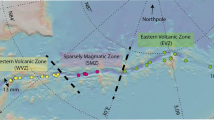Abstract
The sedimentary section (at DSDP Site 495) on the subducting Cocos Plate has large stratigraphic changes in incompatible elements and element ratios, the result of early carbonate deposition followed by late hemipelagic deposition. Lavas from Central America define both local and regional geochemical trends that reflect the strong influence of the two Cocos Plate sediment units. Element ratios with large stratigraphic variations on the Cocos Plate (e.g. Ba/Th, U/La) define local variations within individual volcanic centers in Central America, indicating that marine stratigraphy controls some geochemical characteristics of the lavas. These local trends can be explained by changing the proportions of hemipelagic sediment input into the magma generation process. These local trends are observed in all the segments of the arc, regardless of the intensity of the slab signature. Regional variations are most clearly seen in element ratios that are nearly constant through the Cocos Plate sediment stratigraphy (e.g. Ba/La, U/Th), suggesting that regional variations reflect differences in the intensity of the flux from the subducting slab. The slab signal is strongest in Nicaragua and along the volcanic front. The signal decreases to the northwest and southeast of Nicaragua and toward the back arc. The large slab signature in the lavas from western Nicaragua occurs in the area with the thinnest continental crust and steepest dip of the slab. The mass flux of incompatible elements into the system is easily estimated, except for elements, like Pb, that have high and variable abundances in the basaltic oceanic crust section. The mass flux of elements out of the system depends on eruption rates, which are variable along the arc and only approximately known. Comparison of input and output fluxes for five different segments of the arc reveals that some elements (K, B, Cs, and Rb) are very efficiently delivered to the volcanoes from the subducted slab. Other elements (Sr, Ba, and U) are returned to the surface with moderate efficiency, whereas some elements (REEs) may come mostly from the mantle wedge with minor slab contribution. The relative order of recycling efficiencies of incompatible elements implies that a hydrous fluid dominates the transfer of material from the slab to mantle.
Similar content being viewed by others
Author information
Authors and Affiliations
Additional information
Received: 7 September 1998 / Accepted: 30 September 1999
Electronic Supplementary Material
Rights and permissions
About this article
Cite this article
Patino, L., Carr, M. & Feigenson, M. Local and regional variations in Central American arc lavas controlled by variations in subducted sediment input. Contrib Mineral Petrol 138, 265–283 (2000). https://doi.org/10.1007/s004100050562
Published:
Issue Date:
DOI: https://doi.org/10.1007/s004100050562



